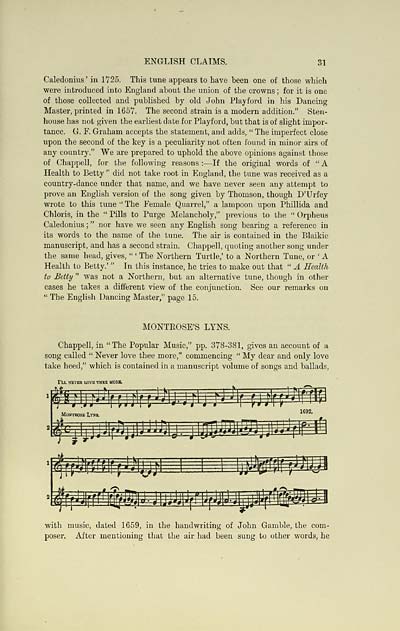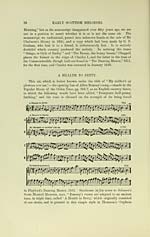Glen Collection of printed music > Printed text > Early Scottish melodies
(53) Page 31 - Montrose's lyns
Download files
Complete book:
Individual page:
Thumbnail gallery: Grid view | List view

ENGLISH CLAIMS.
31
Caledonius' in 1725. This tune appears to have been one of those which
were introduced into England about the union of the crowns ; for it is one
of those collected and published by old John Playford in his Dancing
Master, printed in 1657. The second strain is a modern addition." Sten-
house has not given the earliest date for Playford, but that is of slight impor-
tance. G. F. Graham accepts the statement, and adds, " The imperfect close
upon the second of the key is a peculiarity not often found in minor airs of
any country." We are prepared to uphold the above opinions against those
of Chappell, for the following reasons : — If the original words of " A
Health to Betty " did not take root in England, the tune was received as a
country-dance under that name, and we have never seen any attempt to
prove an English version of the song given by Thomson, though D'Urfey
wrote to this tune •' The Female Quarrel," a lampoon upon Phillida and
Chloris, in the " Pills to Purge Melancholy," previous to the " Orpheus
Caledonius ; " nor have we seen any English song bearing a reference in
its words to the name of the tune. The air is contained in the Blaikie
manuscript, and has a second strain. Chappell, quoting another song under
the same head, gives, " ' The Northern Turtle,' to a Northern Tune, or ' A
Health to Betty.' " In this instance, he tries to make out that " A Health
to Betty " was not a Northern, but an alternative tune, though in other
cases he takes a different view of the conjunction. See our remarks on
" The English Dancing Master," page 15.
MONTEOSE'S LYNS.
Chappell, in "The Popular Music," pp. 378-381, gives an account of a
song called " Never love thee more," commencing " My dear and only love
take heed," which is contained in a manuscript voliune of songs and ballads,
I'll kevkb loyb thbii uosr.
M0HTR03E LyNS,
1692.
f^ i ^j j Jl ( J i jji J JJJ ii j.jii]IJ^iWijiN''JrH
^
*f0\f , ^
3t%WfrT^W^
^|ffJjifrrrifi[ffl i irMi i iJ i iJfriJfj i M.)i^i i i ii^ 6^^
with music, dated 1659, in the handwriting of John Gamble, the com-
poser. After mentioning that the air had been sung to other words, he
31
Caledonius' in 1725. This tune appears to have been one of those which
were introduced into England about the union of the crowns ; for it is one
of those collected and published by old John Playford in his Dancing
Master, printed in 1657. The second strain is a modern addition." Sten-
house has not given the earliest date for Playford, but that is of slight impor-
tance. G. F. Graham accepts the statement, and adds, " The imperfect close
upon the second of the key is a peculiarity not often found in minor airs of
any country." We are prepared to uphold the above opinions against those
of Chappell, for the following reasons : — If the original words of " A
Health to Betty " did not take root in England, the tune was received as a
country-dance under that name, and we have never seen any attempt to
prove an English version of the song given by Thomson, though D'Urfey
wrote to this tune •' The Female Quarrel," a lampoon upon Phillida and
Chloris, in the " Pills to Purge Melancholy," previous to the " Orpheus
Caledonius ; " nor have we seen any English song bearing a reference in
its words to the name of the tune. The air is contained in the Blaikie
manuscript, and has a second strain. Chappell, quoting another song under
the same head, gives, " ' The Northern Turtle,' to a Northern Tune, or ' A
Health to Betty.' " In this instance, he tries to make out that " A Health
to Betty " was not a Northern, but an alternative tune, though in other
cases he takes a different view of the conjunction. See our remarks on
" The English Dancing Master," page 15.
MONTEOSE'S LYNS.
Chappell, in "The Popular Music," pp. 378-381, gives an account of a
song called " Never love thee more," commencing " My dear and only love
take heed," which is contained in a manuscript voliune of songs and ballads,
I'll kevkb loyb thbii uosr.
M0HTR03E LyNS,
1692.
f^ i ^j j Jl ( J i jji J JJJ ii j.jii]IJ^iWijiN''JrH
^
*f0\f , ^
3t%WfrT^W^
^|ffJjifrrrifi[ffl i irMi i iJ i iJfriJfj i M.)i^i i i ii^ 6^^
with music, dated 1659, in the handwriting of John Gamble, the com-
poser. After mentioning that the air had been sung to other words, he
Set display mode to: Large image | Transcription
Images and transcriptions on this page, including medium image downloads, may be used under the Creative Commons Attribution 4.0 International Licence unless otherwise stated. ![]()
| Special collections of printed music > Glen Collection of printed music > Printed text > Early Scottish melodies > (53) Page 31 - Montrose's lyns |
|---|
| Permanent URL | https://digital.nls.uk/91348210 |
|---|
| Description | Scottish songs and music of the 18th and early 19th centuries, including music for the Highland bagpipe. These are selected items from the collection of John Glen (1833 to 1904). Also includes a few manuscripts, some treatises, and other books on the subject. |
|---|
| Description | The Glen Collection and the Inglis Collection represent mainly 18th and 19th century Scottish music, including Scottish songs. The collections of Berlioz and Verdi collected by bibliographer Cecil Hopkinson contain contemporary and later editions of the works of the two composers Berlioz and Verdi. |
|---|

